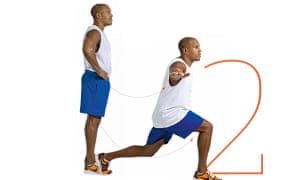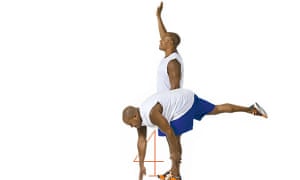Loosen up: exercises to keep backache at bay
There is a common misconception that core strength is all about sit-ups and a six-pack. “In fact, it’s the deeper muscles in your core that support your lower back,” says Fiona Troup, clinic director at Six Physio in London. “These are best strengthened with more subtle exercises that keep them engaged.”
Toe taps
Lie on your back, arms by your sides. Maintain the natural curve in the lower back (neutral spine) and engage your core by gently drawing in the lower abdominals just above your pubic bone. Lift your legs one at a time into a tabletop position (thighs and knees at a right angle), with toes pointed. Keeping your core engaged, breathe out as you slowly lower your right lower leg and tap the floor with your big toe. Return to tabletop as you inhale and repeat with the left leg. Aim for 10 on each side.
Lunges

The simplicity of lunges belies a whole range of benefits. “They boost strength and balance in the pelvis, which in turn contributes to a healthy back,” says Troup. “They’re especially good for runners and people who sit down all day because they open up the hip flexors (the muscle that runs down the front of the hip), which can become tight and lead to back pain.”
Adding in a lateral arm raise activates the deltoid muscles in your shoulder and strengthens your postural muscles. Stand with feet hip-width apart, take a comfortable step forward with your right foot and allow your left heel to lift off the floor. Keeping your torso upright, simultaneously bend your right knee into a right angle (or as close as you can comfortably get) and lower your left knee towards the floor. As you go down, raise both arms out to the side to shoulder height. Repeat 10-15 times, then swap legs. Aim for two sets of 10-15 on each leg.
Squats

“Squats are vital for a healthy back,” says Troup. “They strengthen the core and gluteal muscles in the buttock that support the stability of the pelvis.”
Adding in an arm raise activates the middle and upper back. Stand with feet slightly wider than hip-width apart, toes pointing forward. Align your posture by standing tall and gently engaging the deep abdominal muscles. Slowly fold at the hips and knees, as though you’re going to sit on a chair. At the same time, reach your arms out forwards to shoulder height. Don’t go beyond a right angle with your knees and ensure they don’t knock into each other or go further out than your toes. Aim for three sets of 10-15.
Single-leg balance

Balance is hugely important for a healthy back. “If you have good balance, your muscles react more quickly to stabilise you when you’re moving, which stops your body gripping excessively with the wrong muscles and compressing the lower back,” explains Troup.
Stand with feet hip-width apart. Align your posture by standing tall, gently engage your core and balance on your right leg. Raise your left arm straight up in the air, then reach it forward to touch the floor about 30cm to the outside of the right foot. The left leg reaches behind to counterbalance. Repeat with the opposite leg. Aim for 8-12 on each leg.
Source: Read Full Article


